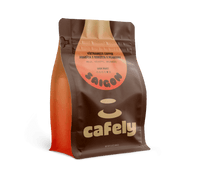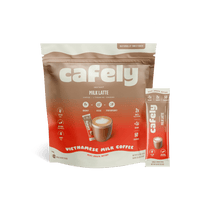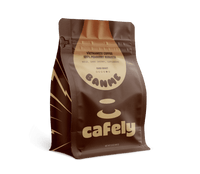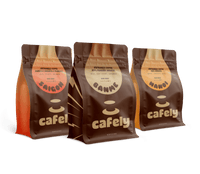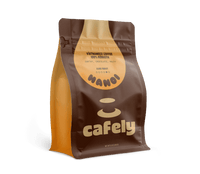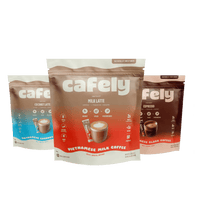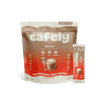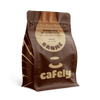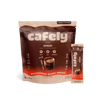If you want to craft premium espresso-based drinks at home, you'll want to start with the bean. You'll be rewarded with rich, bold shots when you pick well.
We’ll take you through everything you need to know, such as the right roast level, grind size, and bean type, so you can make complex, delicious espresso every morning.
How to Choose the Best Coffee Beans for Your Espresso Machine

There are several factors to consider if you want the best coffee beans for espresso.
We’ll take you through each below:
1. Grind Size
When we grind coffee beans, they release their magic and allow us to craft drinks with different qualities. Espresso machines force hot water through the ground coffee, so the beans have to be fine enough to create resistance.
If you grind the coffee too coarsely, the water will flow through the grounds too quickly, not extracting flavor. If you grind too finely, the water will take too long to flow through the grounds, leading to over-extraction.
The best grind size for an espresso machine is very fine. They should be small enough that the bean’s natural oils move to the surface. To test this, press a dry finger to the grounds — if they stick to your finger, they’re moist enough to be ideal for an espresso machine.
2. Bean Freshness
It’s also important to make sure the beans are fresh. The flavors are more intense, and their CO2 content can create crema — the thick, light brown foam that’s the hallmark of espresso quality.
Since coffee beans lose their freshness quicker once ground, it's best to grind right before you need them.
3. Selecting by Roast
When choosing beans for your espresso, you’ll be best served by a dark roast. There are lots of reasons for this, including flavor and chemical solubility.
When coffee is roasted, the compounds within the bean break down into sugars, giving them more flavor [1].
When brewing espresso, each shot averages around thirty seconds, a comparatively short amount of time. Therefore, it’s a good idea to choose a coffee with more naturally generated sugars. Dark roast coffee produces espresso shots that are more flavorful than a light roast.
4. Arabic or Robusta Beans
Both arabica and robusta beans can be good for espresso, but they have major differences to consider.
Arabica for Espresso
Arabica beans contain more fat and sugar than robusta beans, so they have a more complex flavor up for grabs when roasted and brewed in certain ways. Generally, these beans give the final cup a lighter, sweeter flavor than robusta coffee. Tasting notes typically include stone fruit, citrus, and caramelized nuttiness.
When using arabica for espresso, there are a couple of big benefits. The biggest is that the tasting notes of the beans tend to be less bitter, with the higher sugar content allowing for a smoother flavor. This smoother flavor can also pave the way for specialty roasters and baristas brewing espresso with a more complex flavor.
Robusta for Espresso
There are a separate set of benefits when using robusta beans for espresso. For instance, the darker natural flavor of the beans can create an espresso that feels more deep and finished than an arabica solo act. Furthermore, robusta beans lend themselves to a dark roast, which we know already is ideal for an espresso machine.
These dark roasted beans have a deep, rich, and earthy flavor profile, with notes of dark chocolate and smokiness. Because the dark roast brings out the natural sugars of the bean, they can even have a subtle caramel flavor.
Blends for Espresso: The Best of Both Worlds?
Coffee bean blends harmoniously combine the different flavors of each species to create a rich, balanced brew. The goal? To create a final blend greater than the sum of its parts. A premium robusta and arabica blend works by using the robusta as a dark, rich base to provide an intense body and arabica to provide a fruity, delicate sweetness.
For added complexity, skilled roasters might choose to add peaberry beans. These beans are a natural mutation from the coffee plant, in which only one bean forms in a coffee cherry instead of the usual two.
This leads to higher concentrations of flavors and nutrients in that one bean, including sweetness. Blends that include peaberries often cover the whole spectrum of coffee flavors, from the earthy and citrusy robusta-arabica blend to a decadent caramel peaberry.
5. Origin

Many factors cause coffee beans from different locations to offer different qualities. Among the most significant factors at play are the growing altitude and the soil's chemical makeup.
The plant's altitude is directly tied to the acidity of the final coffee bean. High-altitude coffee farms produce beans with notably more chlorogenic acids, leading to more citrus flavors.
The soil also plays a big part since the coffee plant absorbs minerals from the soil. Good soil has more minerals, and more minerals mean more complex flavors. Volcanic soil is prized among coffee growers as it's among the most fertile in the world and can contain many compounds.
Here are some examples of coffee-growing regions and what makes their beans taste so unique:
- Ethiopia — This coffee is typically fruity and floral, with notes of berries. This sweetness comes from the slow ripening process, which allows sugars to develop in the coffee cherry.
- Colombia — This kind is very popular for its mild acidity and smooth chocolate and nut notes. Because the coffee is grown at low altitudes, you'll find less acidity, highlighting the chocolate and nut flavors of the bean.
- Vietnam — Vietnamese coffee is known for its rich earthiness, particularly in coffee from the Vietnamese highlands. These highlands were formed through volcanic activity, so the soil is very rich, producing a bean with complex flavors.
6. Espresso Machine Compatibility
At first glance, you might think that all coffee beans are suitable for all espresso machines. In reality, machines work differently and do best with a specific type of bean.
Let’s break it down by machine type.
Automatic Espresso Machines
If you're using an automatic espresso machine, including the advanced options that brew espresso and prepare milk for you all at once, you may find your machine is best suited to medium-dark roasts. For brewing espresso, this is a good “all-rounder.”
Beans roasted at this level typically preserve a small amount of the native flavors of the coffee bean while also imparting a good amount of flavor from roasting. This means you've got several bases covered when you're unsure what the coffee machine's exact specifications are.
Manual Espresso Machines
Manual machines like the Rok Espresso Maker allow you to adjust the brewing process, from the precise temperature of the water to the duration of any potential pre-infusion stage.
You’ll also have a wider range of beans to choose from with manual machines, but each new coffee choice may require some experimentation to hone in on the best flavor.
Troubleshooting Common Problems
Making great espresso takes practice. Here are some key issues you might face and how to overcome them.
Over- & Under-Extraction
The most common issue is under or over-extracting the brews. Let's look deeper into both issues.
The best way to describe an under-extracted brew is a little sour. Some phytochemicals from the beans have dissolved, but not enough to create that typical coffee flavor. On the other hand, an over-extracted brew is typically very bitter — this flavor tends to eclipse all others, leading to an unpleasant espresso.
To decrease extraction and avoid bitterness, increase the grind size of the beans or decrease the extraction time. Conversely, you can increase extraction by doing the opposite.
Weak Coffee
You may also find that your coffee tastes a little weak and watery — similar to a cup of tea that hasn't spent enough time brewing.
To counteract this, either add a little more coffee or tamp more firmly to press down the coffee bed. Both of these methods ensure that all the brewing water passes through more coffee, leading to more coffee chemicals being dissolved into the cup.
The Importance of Freshness & Proper Storage
Freshness is a huge part of making a delicious espresso because the soluble flavor compounds you want to drink are volatile.
When left sitting on the counter for too long, beans will slowly release flavor. Understanding how long coffee lasts—and storing it properly — helps preserve both aroma and taste. Thankfully, there are ways to avoid this.
Tips on Storing Coffee Beans
When storing coffee beans, it pays to be wary of what will damage them — light, humidity and moisture, heat, and airflow. All these factors will increase the rate at which flavor is lost from the beans. Slow this process down by storing the beans in an airtight, opaque container.
How to Check for Freshness
Fresh beans should have a pleasantly strong aroma of coffee, while stale beans won’t smell at all. Another easy way of checking for freshness is to look at the roasting date on the packaging. Use beans within a month of roasting for optimum freshness.
Best Practices for Bean Longevity
One of the best ways to ensure your beans last is to buy them in smaller quantities. This way, you only have on hand the beans you’ll use while they’re fresh — they simply won’t have time to go stale.
It's also a wise choice to grind beans just before you brew them. When you grind the beans, their surface area increases, making them stale more quickly.
Maintenance & Care of Espresso Machines

One of the main tasks you’ll have to do is descale your espresso machine. This may not sound like a big issue, but limescale can build up quickly when you're regularly boiling water (or bringing it to a near-boiling temperature). Counteract this with descaling products, and you'll ensure your machine's internal components can maintain performance.
The other important elements to clean regularly are the portafilter, basket, and shower screen.
All of these are best cleaned with soap and water — remove any coffee grounds stuck to them, and then wash them as you would dishes or pans. With regular cleaning, your coffee should continue to be flavorsome and clean.
FAQs: Coffee for Espresso Machines
Now that we’ve spoken about the wonderful world of brewing espresso, let’s answer some quick-fire FAQs.
1. What’s the Best Type of Coffee Bean for Espresso?
This is a very tough question since all coffee beans have their strengths. However, out of the top two, we’d suggest opting for robusta beans for their strength and delicious crema. You might choose arabica beans if you’d prefer a more complex flavor and aroma, however. Honestly, it’s all a matter of taste.
2. How Often Should I Deep Clean My Espresso Machine?
If you're brewing at home, you should clean your espresso machine at least once a month. When the machines are used in a commercial setting, however, they should be cleaned more frequently. If you live in an area with hard water, you may need to descale your machine more often.
3. Can Espresso Be Made Without an Espresso Machine?
Technically, no — the only true espresso is made with a machine. However, you can make espresso-like coffee with many tools. You may use a moka pot or an Aeropress brewer with a Fellow Prismo attachment to brew coffee similar to espresso.
4. What Grind Size Is Best for Espresso?
A very fine grind is essential for espresso. The smaller grinds help you extract the maximum flavor and crema from the beans during the short, approximately thirty-second contact time between the grounds and the water.
5. How Does the Water Quality Affect Espresso?
Hard water can lead to mineral deposit buildup in an espresso machine and impart additional flavors to your final brew. Filtered water is best to ensure your espresso is as smooth as possible.
6. What Is the Best Roast Level for Espresso?
Dark roasts are generally considered best for espresso. A dark roast will impart more flavor than a light roast under the same circumstances. Typically, these dark roasts provide a rich, full-bodied flavor.
7. Can I Use Regular Coffee Beans in an Espresso Machine?
You can technically use any beans or grind in an espresso machine. However, coffee beans roasted to an "espresso level" and ground to an "espresso fineness" are optimized for brewing in an espresso machine and give the best flavor.
8. How Often Should I Replace My Espresso Beans?
For optimum freshness, it's worth using up your espresso beans within a month of the roast date. Beyond that time, the beans will taste a little flat and stale as they lose their inherent flavor compounds.
9. Does the Type of Espresso Machine I Use Affect the Choice of Beans?
To some extent, yes — different machines will interact with different beans in unique ways. Through a little trial and error, you’ll be able to find what kind of beans your espresso machine can work with best.
10. What Are Peaberry Beans, & Why Are They Special?
Like regular coffee beans, peaberry beans are the seed of a coffee cherry. However, peaberry cherries have undergone a natural mutation in around 10% of the world's coffee experiences, by which only one bean forms at the center of the cherry rather than two. This bean is typically rounder and has a more concentrated flavor.
References
- Redgwell, R. J., Trovato, V., Curti, D., & Fischer, M. (2002). Effect of roasting on degradation and structural features of polysaccharides in Arabica coffee beans. Carbohydrate research, 337(5), 421—431.
